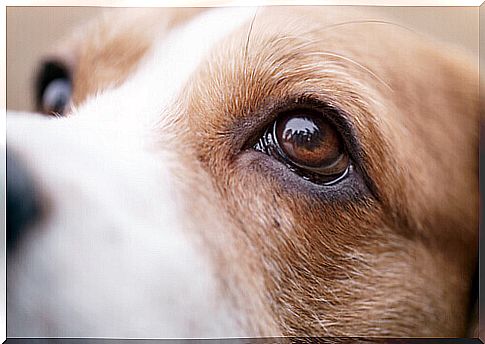Conjunctivitis In Dogs: Symptoms, Prevention And Treatment

Conjunctivitis is an inflammatory disease that affects dogs’ eyes. Good hygiene is essential to avoid it.
Conjunctivitis is just as irritating and painful for dogs as it is for humans. It is important to know how to identify its symptoms, as well as their causes, so that we can ensure that our dog’s vision is not at risk.
Causes and symptoms of canine conjunctivitis
Conjunctivitis can affect both cats and dogs. It is an inflammation of the conjunctiva, a membrane that covers the back of the eyelids and the inside of the eyes. It is common in species that tend to contract autoimmune skin diseases and have dry eyes.
Canine conjunctivitis can be viral, bacterial or allergic. The symptoms our pet has can help us discern the causes of inflammation. Among them we have:
- twitching eyes
- Very wet or red eye tissue
- Eye secretions, which may be transparent or contain mucus or pus
- Swelling due to accumulation of fluid in the conjunctiva
- Formation of lymphoid follicles in the conjunctiva. We call a “follicle” a small translucent sac-like structure that appears in the ocular mucosa in response to external injury or infection. This symptom is characteristic of follicular conjunctivitis.
- Hypersensitivity to light. If our pet rejects sunlight, it is likely to have some kind of eye infection.

In all these cases, it is essential to take our pet to the vet so that a proper diagnosis can be made. One of the most used diagnostic methods is ocular angiography, a test in which a fluorescent substance is injected into the animal’s eye to look for possible ulcers or changes in the retina’s vascular system.
Types of canine conjunctivitis
The type of injury or infection in our dog will determine the symptoms and treatments of the disease. Here is a list of the most common diseases:
- Infectious conjunctivitis. It can be of viral or bacterial origin, both being contagious. To identify the infectious agent that caused it, we must pay attention to the symptoms. Thus, if our animal has a cold and we find that its eyes expel a substance that is more liquid than thick, it is likely to be viral conjunctivitis. If it is bacterial, the expelled liquid will be thicker.
- Autoimmune conjunctivitis. These are allergic or follicular conjunctivitis . The first is related to springtime allergic rhinitis or the increase in pollen in nature, among others.
- Neonatal conjunctivitis. It is usually associated with viral or bacterial conjunctivitis.

Other possible very common cases are conjunctivitis derived from the presence of eye tumors or other diseases, such as glaucoma or ulcerative keratitis.
Treatment and Prevention
The key to preventing canine conjunctivitis is hygiene. We must ensure that our dogs have the ocular region as clean as possible.

For this, it is advisable to remove the excessive hair from the eyes of animals that accumulate a lot of fur in this region. Dogs’ fur tends to accumulate dirt and germs, which is a good first step in preventing them from getting infections.
As for the treatment, we must take into account that the origin of the conjunctivitis (a virus, bacteria, etc.) will be decisive. In any case, it is essential to clean the eye with saline solution and remove secretions and foreign bodies.
The drops should be prescribed by a veterinarian, as many contain steroids that, depending on the type of illness, can worsen symptoms.









